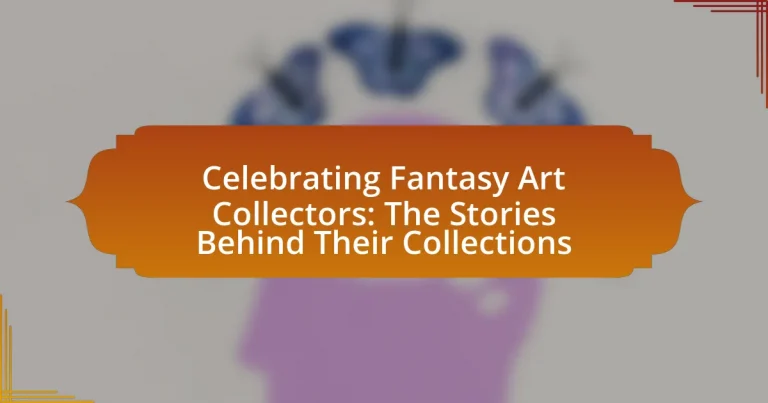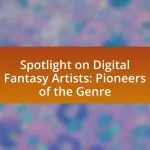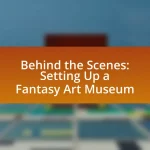Fantasy art collectors are individuals dedicated to acquiring and curating artworks that embody fantastical themes, characters, and worlds. This article explores the defining characteristics of these collectors, including their selection processes influenced by personal taste, emotional connections, and artist reputations. It examines how personal interests shape their collections, the cultural significance of fantasy art, and the common themes prevalent in these collections. Additionally, the article highlights the role of artists in shaping these themes, the impact of online communities and conventions on sharing collections, and offers tips for aspiring collectors to build their own collections effectively.
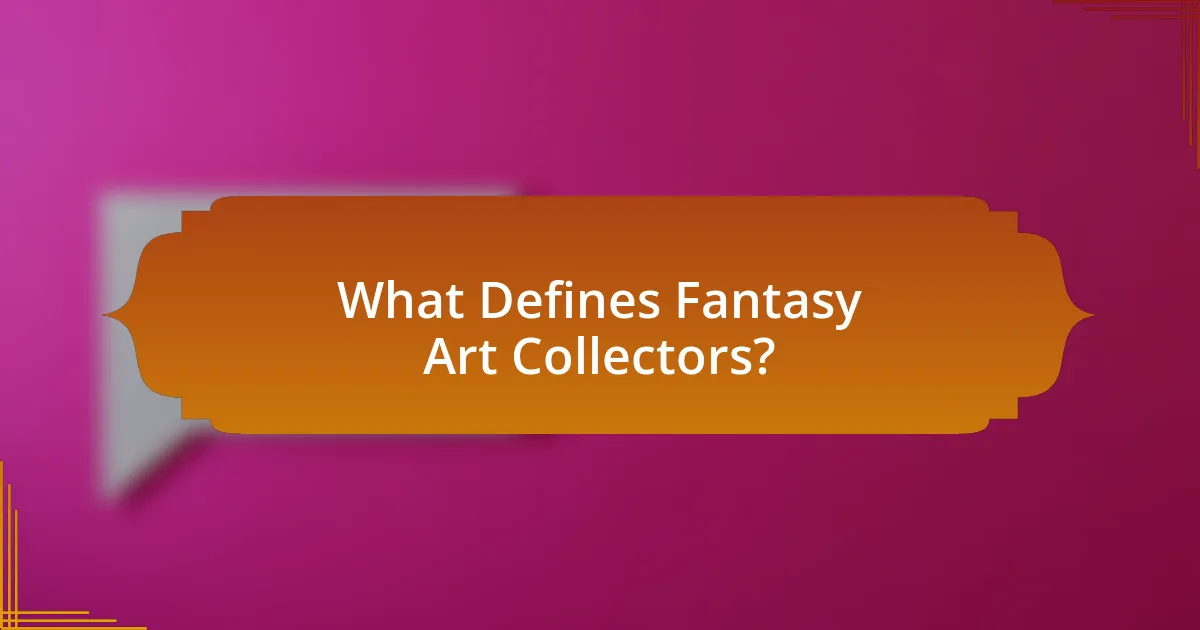
What Defines Fantasy Art Collectors?
Fantasy art collectors are individuals who actively seek, acquire, and curate artworks that depict fantastical themes, characters, and worlds. These collectors often have a deep appreciation for the genre, which includes illustrations from fantasy literature, concept art from films and games, and original pieces from artists specializing in fantasy. Their collections may reflect personal interests, such as specific artists, styles, or sub-genres within fantasy art, and they often engage with the community through conventions, exhibitions, and online platforms. The growth of fantasy art collecting has been supported by the increasing popularity of fantasy genres in media, evidenced by the success of franchises like “The Lord of the Rings” and “Game of Thrones,” which have inspired a surge in both interest and investment in related artworks.
How do fantasy art collectors choose their collections?
Fantasy art collectors choose their collections based on personal taste, thematic interest, and the reputation of the artists. Collectors often seek pieces that resonate with their individual experiences or emotions, focusing on specific genres such as high fantasy, dark fantasy, or surrealism. Additionally, they consider the artist’s background, previous works, and market value, which can influence the desirability of a piece. For instance, collectors may prioritize works by renowned artists like Frank Frazetta or Julie Bell, whose contributions have significantly shaped the fantasy art landscape. This approach ensures that their collections not only reflect their aesthetic preferences but also hold potential investment value.
What factors influence their selection process?
The selection process of fantasy art collectors is influenced by personal taste, emotional connection to the artwork, and the reputation of the artist. Personal taste dictates the aesthetic preferences that guide collectors in choosing pieces that resonate with them. Emotional connection plays a crucial role, as collectors often seek artworks that evoke specific feelings or memories. Additionally, the reputation of the artist can significantly impact a collector’s decision, as established artists may offer perceived value and investment potential. These factors collectively shape the choices made by collectors in building their fantasy art collections.
How do personal interests shape their collections?
Personal interests significantly shape collections by guiding the selection of items that resonate with the collector’s passions and experiences. For instance, a collector with a deep appreciation for fantasy literature may focus on acquiring artwork that depicts scenes or characters from their favorite books, thereby creating a collection that reflects their personal narrative and aesthetic preferences. This alignment between personal interests and collection choices is evident in the way collectors often seek out specific artists or styles that evoke emotional connections, leading to a curated assortment that tells a unique story about their individual tastes and inspirations.
Why is collecting fantasy art significant?
Collecting fantasy art is significant because it preserves and promotes cultural narratives and imaginative expressions that reflect human creativity. This genre often encapsulates themes of mythology, folklore, and speculative fiction, allowing collectors to engage with diverse artistic interpretations and historical contexts. For instance, the rise of fantasy art in the 20th century, particularly through artists like Frank Frazetta and Boris Vallejo, has influenced popular culture, including films and video games, thereby solidifying its importance in both art history and contemporary media. Collectors contribute to the appreciation and valuation of these works, ensuring that they remain part of the cultural dialogue.
What cultural impacts do fantasy art collections have?
Fantasy art collections significantly influence cultural perceptions by shaping narratives around imagination and creativity. These collections often serve as a visual representation of cultural myths, folklore, and shared human experiences, fostering a sense of community among enthusiasts. For instance, exhibitions of fantasy art can promote discussions about identity, diversity, and the human condition, as seen in events like the World Fantasy Convention, which highlights the importance of fantasy in literature and art. Additionally, fantasy art collections can inspire new generations of artists and writers, contributing to the evolution of cultural expressions in contemporary society.
How do these collections reflect individual identities?
Collections of fantasy art reflect individual identities by showcasing personal tastes, experiences, and cultural influences. Each collector curates pieces that resonate with their unique perspectives, often selecting artworks that evoke specific emotions or memories. For instance, a collector may focus on works that represent their favorite fantasy narratives or characters, illustrating their personal connection to those stories. Additionally, the diversity in styles and themes within a collection can indicate the collector’s background, interests, and values, revealing how their identity shapes their artistic preferences. This interplay between art and identity is evident in the way collectors often share the stories behind their acquisitions, further emphasizing the personal significance of each piece.
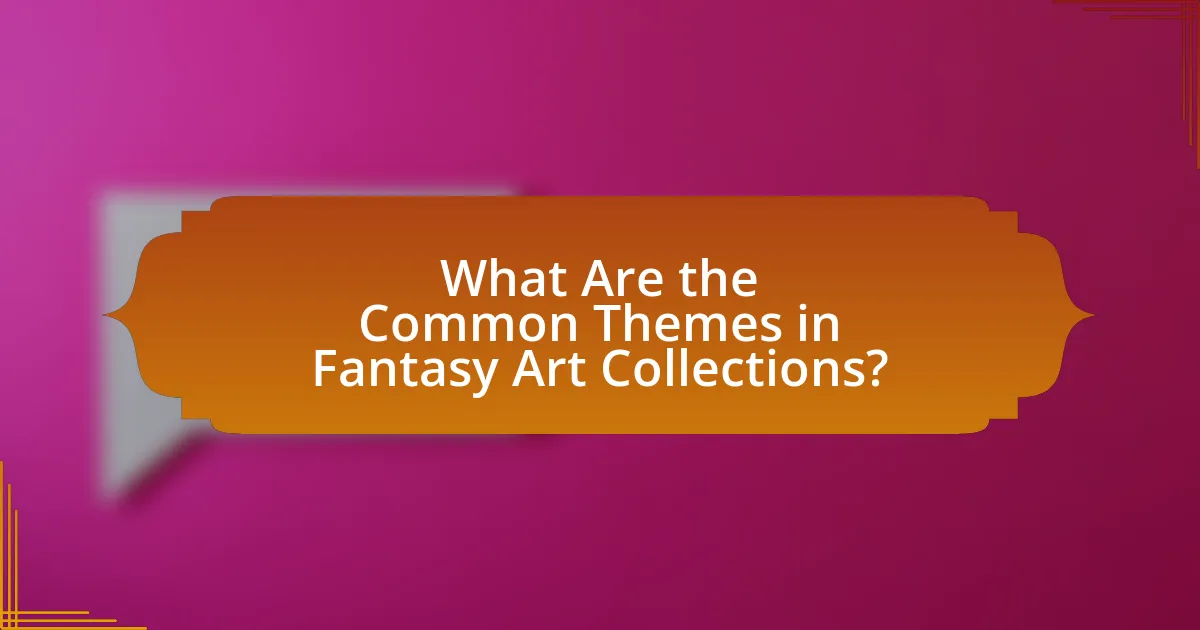
What Are the Common Themes in Fantasy Art Collections?
Common themes in fantasy art collections include mythical creatures, epic battles, enchanted landscapes, and heroic characters. These themes often reflect the imagination and creativity inherent in fantasy genres, showcasing elements such as dragons, fairies, and wizards, which are staples in fantasy narratives. Additionally, many collections emphasize the contrast between light and dark, exploring themes of good versus evil, as seen in works inspired by classic literature and folklore. The prevalence of these themes can be traced back to the influence of iconic fantasy authors like J.R.R. Tolkien and C.S. Lewis, whose works have shaped the visual representation of fantasy art.
How do themes of fantasy manifest in art collections?
Themes of fantasy manifest in art collections through the depiction of imaginative worlds, mythical creatures, and surreal narratives. Artworks often feature elements such as vibrant colors, dreamlike landscapes, and characters drawn from folklore or mythology, which transport viewers to alternate realities. For instance, collections may include pieces inspired by literary works like J.R.R. Tolkien’s “The Lord of the Rings,” showcasing elves, dragons, and enchanted forests, thereby illustrating the influence of fantasy literature on visual art. Additionally, artists like Salvador Dalí and Max Ernst have incorporated fantastical elements into their surrealist works, further emphasizing the intersection of fantasy and art. These manifestations not only reflect the artists’ creative visions but also resonate with collectors who seek to explore and celebrate the boundless possibilities of imagination.
What are the most popular themes among collectors?
The most popular themes among collectors include fantasy, science fiction, and historical art. These themes resonate strongly due to their ability to evoke imagination and nostalgia. For instance, fantasy art often features mythical creatures and magical landscapes, appealing to those who enjoy escapism. Science fiction themes attract collectors interested in futuristic concepts and technology, while historical art connects individuals to past events and cultures. Collectors are drawn to these themes because they offer a sense of identity and community, as evidenced by the growth of conventions and online forums dedicated to these genres.
How do these themes evolve over time?
Themes in fantasy art collections evolve over time through shifts in cultural influences, technological advancements, and changing artistic styles. For instance, early fantasy art was heavily influenced by mythology and folklore, reflecting the societal values and beliefs of the time. As the genre progressed, the rise of digital art in the late 20th century introduced new techniques and accessibility, allowing a broader range of artists to contribute to the fantasy art landscape. Additionally, contemporary themes often incorporate diverse narratives and inclusive representation, mirroring societal changes and the growing demand for varied perspectives in art. This evolution is evidenced by the increasing popularity of fantasy art conventions and online platforms, which showcase a wider array of artistic expressions and foster community engagement among collectors and creators.
What role do artists play in shaping these themes?
Artists play a crucial role in shaping themes within fantasy art collections by creating visual narratives that reflect cultural, emotional, and imaginative elements. Through their unique styles and perspectives, artists influence the interpretation of fantasy themes, allowing collectors to connect with the artwork on a deeper level. For instance, artists like Frank Frazetta and Boris Vallejo have defined the aesthetic of fantasy art, inspiring collectors to seek pieces that resonate with their personal experiences and aspirations. Their works often incorporate mythological and fantastical elements, which not only enrich the genre but also guide collectors in understanding and appreciating the thematic depth of their collections.
How do collaborations between artists and collectors influence collections?
Collaborations between artists and collectors significantly influence collections by fostering unique artworks that reflect both the artist’s vision and the collector’s preferences. These partnerships often lead to the creation of limited edition pieces or bespoke commissions, which enhance the value and uniqueness of a collection. For instance, when a collector collaborates with an artist to develop a specific theme or concept, the resulting artwork not only embodies the artistic style but also resonates with the collector’s personal narrative, thereby enriching the collection’s story. This dynamic can be observed in various art markets, where collaborative projects have resulted in increased demand and appreciation for both the artist’s work and the collector’s collection.
What are some notable artists in the fantasy art genre?
Notable artists in the fantasy art genre include Frank Frazetta, Boris Vallejo, and Julie Bell. Frank Frazetta is renowned for his dynamic compositions and muscular figures, significantly influencing the visual style of fantasy art since the 1960s. Boris Vallejo is celebrated for his hyper-realistic paintings that often feature mythological and fantastical themes, contributing to book covers and calendars. Julie Bell, known for her collaboration with Vallejo, combines traditional techniques with a modern aesthetic, creating striking images that resonate within the fantasy community. These artists have shaped the genre through their distinctive styles and contributions to various media, including illustrations, paintings, and merchandise.
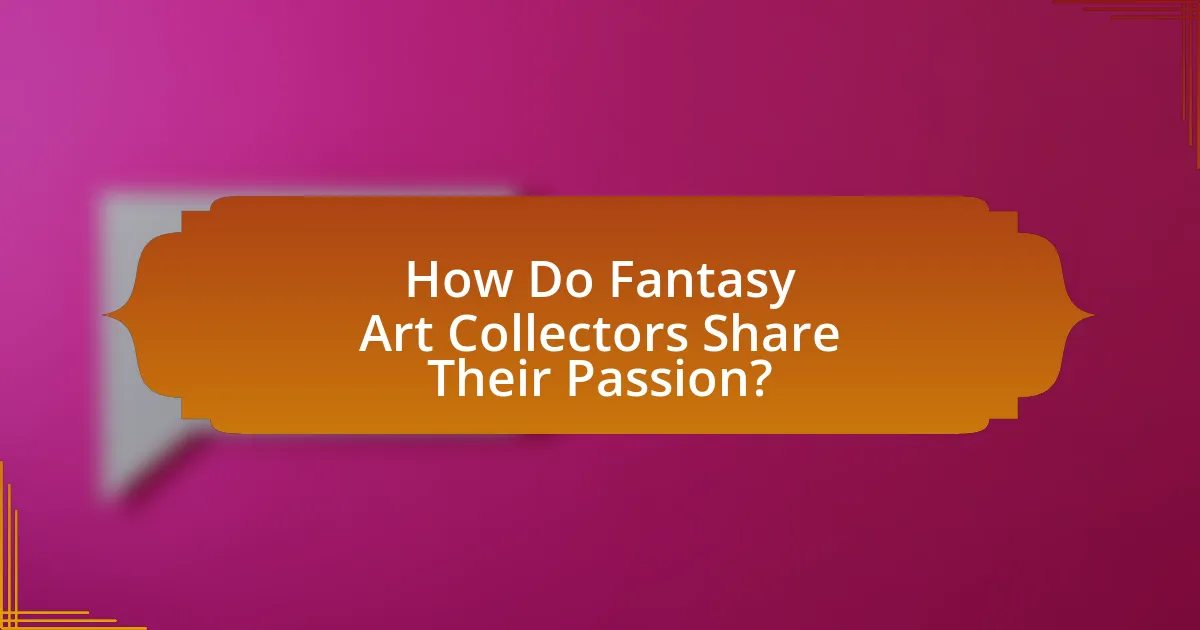
How Do Fantasy Art Collectors Share Their Passion?
Fantasy art collectors share their passion primarily through online communities, social media platforms, and art exhibitions. These collectors actively participate in forums and groups dedicated to fantasy art, where they discuss their favorite artists, share their collections, and exchange insights about the genre. For instance, platforms like Instagram and Pinterest allow collectors to showcase their artwork, connect with other enthusiasts, and discover new pieces. Additionally, many collectors attend conventions and art shows, such as Comic-Con, where they can meet artists, purchase exclusive works, and engage with fellow fans. This engagement fosters a vibrant community that celebrates and promotes the appreciation of fantasy art.
What platforms do collectors use to showcase their collections?
Collectors use platforms such as Instagram, Pinterest, and specialized websites like ArtStation and DeviantArt to showcase their collections. These platforms allow collectors to visually present their artwork, engage with a community of enthusiasts, and gain visibility for their collections. For instance, Instagram’s visual-centric approach enables collectors to share high-quality images and connect with followers, while ArtStation caters specifically to artists and collectors in the digital art space, providing a professional environment for showcasing portfolios.
How do social media and online galleries impact visibility?
Social media and online galleries significantly enhance visibility for artists and their work. These platforms allow creators to showcase their art to a global audience, breaking geographical barriers that traditional galleries impose. For instance, a study by the Pew Research Center found that 69% of adults in the U.S. use social media, providing artists with a vast potential audience. Additionally, online galleries often feature search engine optimization (SEO) strategies that increase discoverability, allowing artworks to be found through search engines. This combination of broad reach and enhanced discoverability leads to increased opportunities for engagement, sales, and recognition in the art community.
What role do conventions and exhibitions play in sharing collections?
Conventions and exhibitions serve as vital platforms for sharing collections by providing opportunities for collectors to showcase their works to a broader audience. These events facilitate direct interaction between collectors, artists, and enthusiasts, fostering community engagement and appreciation for the art. For instance, major conventions like Comic-Con attract thousands of attendees, allowing collectors to display their pieces, network with other collectors, and participate in discussions that enhance the visibility of their collections. This interaction not only promotes individual collections but also contributes to the overall cultural dialogue surrounding fantasy art, thereby enriching the community and encouraging the preservation of artistic heritage.
How can collectors connect with each other?
Collectors can connect with each other through online forums, social media groups, and local meetups dedicated to their specific interests. Online platforms like Facebook, Reddit, and specialized collector websites facilitate discussions, sharing of collections, and networking opportunities. Additionally, attending conventions and art shows allows collectors to meet in person, exchange ideas, and build relationships within the community. These methods are effective as they provide spaces for collectors to share knowledge, trade items, and foster a sense of belonging among enthusiasts.
What communities exist for fantasy art collectors?
Communities for fantasy art collectors include online platforms such as DeviantArt, ArtStation, and social media groups on Facebook and Reddit. These platforms facilitate interaction among collectors, artists, and enthusiasts, allowing for the sharing of artwork, discussions about collecting, and networking opportunities. For instance, the Facebook group “Fantasy Art Collectors” has thousands of members who actively engage in buying, selling, and showcasing fantasy art. Additionally, conventions like Gen Con and Comic-Con often feature dedicated spaces for fantasy art collectors, providing a physical venue for community building and exchange.
How do these communities foster collaboration and sharing?
These communities foster collaboration and sharing by creating platforms for artists and collectors to connect, exchange ideas, and showcase their work. For instance, online forums and social media groups dedicated to fantasy art allow members to share their collections, provide feedback, and collaborate on projects, enhancing the sense of community. Additionally, events such as conventions and exhibitions facilitate face-to-face interactions, where individuals can network, share techniques, and discuss their passion for fantasy art, further promoting collaboration.
What Tips Can Help Aspiring Fantasy Art Collectors?
Aspiring fantasy art collectors should focus on researching artists and understanding their styles to make informed purchasing decisions. Familiarizing oneself with the fantasy art genre, including its history and key figures, enhances appreciation and helps identify valuable pieces. Engaging with online communities and attending conventions can provide insights into trends and emerging artists, while setting a budget ensures financial sustainability. Collectors should also consider the provenance of artworks, as pieces with a documented history often hold greater value.
How should new collectors start building their collections?
New collectors should start building their collections by identifying a specific theme or genre that resonates with them, such as fantasy art. This focused approach allows collectors to develop a deeper understanding of the subject matter and make informed purchasing decisions. Researching artists, attending art shows, and joining collector communities can provide valuable insights and networking opportunities. According to a survey by the Art Dealers Association of America, 70% of collectors emphasize the importance of community engagement in enhancing their collecting experience. This engagement not only fosters knowledge but also helps in discovering unique pieces that align with their interests.
What resources are available for learning about fantasy art?
Resources for learning about fantasy art include online courses, books, tutorials, and community forums. Online platforms like Skillshare and Udemy offer structured courses taught by experienced artists, covering techniques and styles specific to fantasy art. Books such as “Fantasy Art Workshop” by John Howe and “The Art of Fantasy” provide in-depth insights and practical guidance. Additionally, websites like DeviantArt and ArtStation serve as community hubs where artists share their work and techniques, allowing for peer feedback and inspiration. These resources collectively support skill development and knowledge in the field of fantasy art.
